Formica lasioides
| Formica lasioides | |
|---|---|

| |
| Scientific classification | |
| Kingdom: | Animalia |
| Phylum: | Arthropoda |
| Class: | Insecta |
| Order: | Hymenoptera |
| Family: | Formicidae |
| Subfamily: | Formicinae |
| Tribe: | Formicini |
| Genus: | Formica |
| Species: | F. lasioides |
| Binomial name | |
| Formica lasioides Emery, 1893 | |
| Subspecies | |
| |
| Synonyms | |
| |
This is a common species, which nests in the soil, usually under stones or logs.
Identification
A small Formica with its entire surface smooth and polished. The pronotum has 10 or more erect hairs and the scape has numerous, short, delicate, white hairs. Most other body parts are covered with bristly hairs. (Mackay and Mackay 2002)
Distribution
Widespread in North America.
Latitudinal Distribution Pattern
Latitudinal Range: 54.856047° to 30.88333333°.
| North Temperate |
North Subtropical |
Tropical | South Subtropical |
South Temperate |
- Source: AntMaps
Distribution based on Regional Taxon Lists
Nearctic Region: Canada, United States (type locality).
Neotropical Region: Mexico.
Distribution based on AntMaps
Distribution based on AntWeb specimens
Check data from AntWeb
Countries Occupied
| Number of countries occupied by this species based on AntWiki Regional Taxon Lists. In general, fewer countries occupied indicates a narrower range, while more countries indicates a more widespread species. |

|
Habitat
In New Mexico (Mackay and Mackay 2002) - Primarily pine forest, ponderosa pine-riparian, fir forests, spruce and aspen forests, pinyon pine, oak forest, although it occurs in other habitats, including semiarid grasslands.
Biology
For New Mexico (Mackay and Mackay 2002) - Brood was collected in nests in July and August. Two dealate females were collected on the soil surface on 6 Aug. 1986. It nests together (possibly enslaved by) with Formica occulta. One colony was nesting together with Lasius pallitarsis, several nests contained colonies of Leptothorax crassipilis. One mixed nest included F. argentea, F. aserva, F. obtusopilosa, F. rubicunda, F. lasioides and Myrmica. These ants are docile, and escape when the nest is excavated.
Nevada, Wheeler and Wheeler (1986) - In Nevada lasioides is well scattered throughout the state, although most (87%) of the records are above 6,000 ft. We have 79 records for this species from 56 localities; 3,800-10,900 ft. Of these records 4 were in the Alpine Biome, 40 in the Coniferous Forest Biome, 8 in the Pinyon-Juniper, and 16 in the Cool Desert (3 in sand dunes and 1 in a disturbed area). Of the nests for which we have descriptions, the majority were under stones; those exposed were surmounted by a low irregular messy pile of soil, which in some cases resembled a crater; such structures ranged from 4 to 30 cm in diameter. This is a rapid-moving and timid species, but residents of populous colonies are sometimes aggressive and their bites are annoying.
Formica pergandei is a host for the following species dulotic species:
It is also a host for the temporary parasite Formica microgyna.
Association with Other Organisms
 Explore: Show all Associate data or Search these data. See also a list of all data tables or learn how data is managed.
Explore: Show all Associate data or Search these data. See also a list of all data tables or learn how data is managed.
- This species is a mutualist for the aphid Aphis asclepiadis (a trophobiont) (Addicott, 1979a; Saddiqui et al., 2019).
- This species is a mutualist for the aphid Aphis salicariae (a trophobiont) (Addicott, 1979a; Saddiqui et al., 2019).
- This species is a mutualist for the aphid Aphis varians (a trophobiont) (Addicott, 1978; Addicott, 1979a; Saddiqui et al., 2019).
- This species is a mutualist for the aphid Rhopalosiphum nymphaeae (a trophobiont) (Jones, 1927; Saddiqui et al., 2019).
- This species is a host for the fungus Laboulbenia formicarum (a parasite) (Quevillon, 2018) (encounter mode primary; direct transmission; transmission within nest).
- This species is a host for the fungus Laboulbenia formicarum (a pathogen) (Espadaler & Santamaria, 2012).
Castes
Worker
  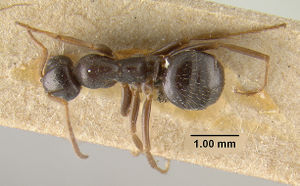 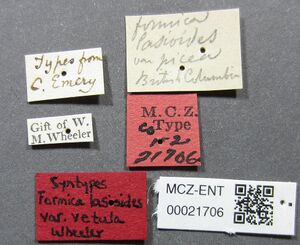    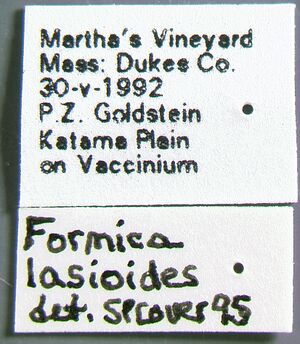
| |
| . | Owned by Museum of Comparative Zoology. |
Images from AntWeb
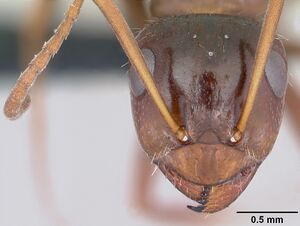   
| |
| Worker. Specimen code casent0064827. Photographer April Nobile, uploaded by California Academy of Sciences. | Owned by CAS, San Francisco, CA, USA. |
  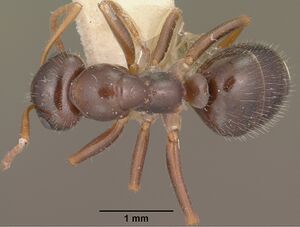 
| |
| Worker. Specimen code casent0102797. Photographer Jen Fogarty, uploaded by California Academy of Sciences. | Owned by CAS, San Francisco, CA, USA. |
Nomenclature
The following information is derived from Barry Bolton's Online Catalogue of the Ants of the World.
- lasioides. Formica lasioides Emery, 1893i: 664 (w.) U.S.A. Combination in Proformica: Emery, 1912f: 100; in Formica (Proformica): Wheeler, W.M. 1913f: 539; in Formica: Francoeur, 1973: 114. Subspecies of fusca: Wheeler, W.M. 1908g: 409; of neogagates: Wheeler, W.M. 1913f: 539. Revived status as species and senior synonym of vetula: Creighton, 1950a: 457.
- picea. Formica lasioides var. picea Emery, 1895c: 335 (w.) U.S.A. [Junior primary homonym of picea Leach, 1825: 292, above.] Replacement name: vetula Wheeler, W.M. 1912c: 90.
- vetula. Formica lasioides var. vetula Wheeler, W.M. 1912c: 90. Replacement name for picea Emery, 1895c: 335. [Junior primary homonym of picea Leach, 1825: 292.] Wheeler, W.M. 1917a: 554 (q.). Combination in F. (Proformica): Wheeler, W.M. 1913f: 540. Subspecies of neogagates: Buren, 1944a: 308. Junior synonym of lasioides: Creighton, 1950a: 458.
Description
References
- Alatorre-Bracamontes, C.E., Vásquez-Bolaños, M. 2010. Lista comentada de las hormigas (Hymenoptera: Formicidae) del norte de México. Dugesiana 17(1): 9-36.
- Borowiec, M.L., Cover, S.P., Rabeling, C. 2021. The evolution of social parasitism in Formica ants revealed by a global phylogeny. Proceedings of the National Academy of Sciences 118, e2026029118 (doi:10.1073/pnas.2026029118).
- Carroll, T.M. 2011. The ants of Indiana (Hymenoptera: Formicidae). M.S. thesis, Purdue University.
- Creighton, W. S. 1950a. The ants of North America. Bulletin of the Museum of Comparative Zoology 104: 1-585 (page 457, Revived status as species, and senior synonym of vetula)
- Emery, C. 1893k. Beiträge zur Kenntniss der nordamerikanischen Ameisenfauna. Zool. Jahrb. Abt. Syst. Geogr. Biol. Tiere 7: 633-682 (page 664, worker described)
- Emery, C. 1912f. Der Wanderzug der Steppen- und Wüstenameisen von Zentral-Asien nach Süd-Europa und Nord-Afrika. Zool. Jahrb. Suppl. 15("Erster Ba Band: 95-104 (page 100, Combination in Proformica)
- Espadaler, X., Santamaria, S. 2012. Ecto- and Endoparasitic Fungi on Ants from the Holarctic Region. Psyche Article ID 168478, 10 pages (doi:10.1155/2012/168478).
- Francoeur, A. 1973. Révision taxonomique des espèces néarctiques du groupe fusca, genre Formica (Formicidae, Hymenoptera). Mém. Soc. Entomol. Qué. 3: 1-316 (page 114, Combination in Formica)
- Ivanov, K. 2019. The ants of Ohio (Hymenoptera, Formicidae): an updated checklist. Journal of Hymenoptera Research 70: 65–87 (doi:10.3897@jhr.70.35207).
- Mackay, W. P. and E. Mackay. 2002. The ants of New Mexico (Hymenoptera: Formicidae). Edwin Mellen Press, Lewiston, NY.
- Siddiqui, J. A., Li, J., Zou, X., Bodlah, I., Huang, X. 2019. Meta-analysis of the global diversity and spatial patterns of aphid-ant mutualistic relationships. Applied Ecology and Environmental Research 17: 5471-5524 (doi:10.15666/aeer/1703_54715524).
- Snelling, R. R.; Buren, W. F. 1985. Description of a new species of slave-making ant in the Formica sanguinea group (Hymenoptera: Formicidae). Great Lakes Entomologist 18: 69-78.
- Vatanparast, M., Park, Y. 2021. Comparative RNA-Seq analyses of Solenopsis japonica (Hymenoptera: Formicidae) reveal gene in response to cold stress. Genes 12, 1610 (doi:10.3390/genes12101610).
- Wheeler, G. C. and J. Wheeler. 1986. The ants of Nevada. Natural History Museum of Los Angeles County, Los Angeles.
- Wheeler, W. M. 1908h. The ants of Texas, New Mexico and Arizona. (Part I.). Bull. Am. Mus. Nat. Hist. 24: 399-485 (page 409, Subspecies of fusca)
- Wheeler, W. M. 1913i. A revision of the ants of the genus Formica (Linné) Mayr. Bulletin of the Museum of Comparative Zoology 53: 379-565 (page 539, Combination in Formica (Proformica), Subspecies of neogagates)
References based on Global Ant Biodiversity Informatics
- Allred D. M. 1982. Ants of Utah. The Great Basin Naturalist 42: 415-511.
- Allred D. M. and A. C. Cole. 1971. Ants of the national reactor testing station. Great Basin Naturalist. 31: 237-242
- Allred D. M., and A. C. Cole, Jr. 1971. Ants of the National Reactor Testing Station. Great Basin Naturalist 31: 237-242.
- Allred, D.M. 1982. The ants of Utah. Great Basin Naturalist 42:415-511.
- Banschbach V. S., and E. Ogilvy. 2014. Long-term Impacts of Controlled Burns on the Ant Community (Hymenoptera: Formicidae) of a Sandplain Forest in Vermont. Northeastern Naturalist 21(1): 1-12.
- Bestelmeyer B. T., and J. A. Wiens. 2001. Local and regional-scale responses of ant diversity to a semiarid biome transition. Ecography 24: 381-392.
- Blacker, N.C. 1992. Some Ants from Southern Vancouver Island, British Columbia. J. Entomol. Soc. Bri. Columbia 89:3-12.
- Blacker, N.C. 1992. Some ants (Hymenoptera: Formicidae) from Southern Vancouver Island, British Columbia. Journal of the Entomological Society of British Columbia 89:3-12
- Borchert, H.F. and N.L. Anderson. 1973. The Ants of the Bearpaw Mountains of Montana (Hymenoptera: Formicidae). Journal of the Kansas Entomological Society 46(2):200-224
- Canadensys Database. Dowloaded on 5th February 2014 at http://www.canadensys.net/
- Carroll T. M. 2011. The ants of Indiana (Hymenoptera: Formicidae). Master's Thesis Purdue university, 385 pages.
- Choate B., and F. A. Drummond. 2012. Ant Diversity and Distribution (Hymenoptera: Formicidae) Throughout Maine Lowbush Blueberry Fields in Hancock and Washington Counties. Environ. Entomol. 41(2): 222-232.
- Choate B., and F. A. Drummond. 2013. The influence of insecticides and vegetation in structuring Formica Mound ant communities (Hymenoptera: Formicidae) in Maine lowbush blueberry. Environ. Entomol. 41(2): 222-232.
- Clark Adam. Personal communication on November 25th 2013.
- Cole A. C., Jr. 1936. An annotated list of the ants of Idaho (Hymenoptera: Formicidae). Canadian Entomologist 68: 34-39.
- Cole A. C., Jr. 1942. The ants of Utah. American Midland Naturalist 28: 358-388.
- Cole, A.C. 1936. An annotated list of the ants of Idaho (Hymenoptera; Formicidae). Canadian Entomologist 68(2):34-39
- Coovert G. A. 2005. The Ants of Ohio (Hymenoptera: Formicidae). Ohio Biological Survey, Inc. 15(2): 1-207.
- Coovert, G.A. 2005. The Ants of Ohio (Hymenoptera: Formicidae) Ohio Biological Survey Bulletin New Series Volume 15(2):1-196
- Dattilo W. et al. 2019. MEXICO ANTS: incidence and abundance along the Nearctic-Neotropical interface. Ecology https://doi.org/10.1002/ecy.2944
- Del Toro I., K. Towle, D. N. Morrison, and S. L. Pelini. 2013. Community Structure, Ecological and Behavioral Traits of Ants (Hymenoptera: Formicidae) in Massachusetts Open and Forested Habitats. Northeastern Naturalist 20: 1-12.
- Del Toro, I. 2010. PERSONAL COMMUNICATION. MUSEUM RECORDS COLLATED BY ISRAEL DEL TORO
- Downing H., and J. Clark. 2018. Ant biodiversity in the Northern Black Hills, South Dakota (Hymenoptera, Formicidae). Journal of the Kansas Entomological Society 91(2): 119-132.
- Drummond F. A., A. M. llison, E. Groden, and G. D. Ouellette. 2012. The ants (Formicidae). In Biodiversity of the Schoodic Peninsula: Results of the Insect and Arachnid Bioblitzes at the Schoodic District of Acadia National Park, Maine. Maine Agricultural and forest experiment station, The University of Maine, Technical Bulletin 206. 217 pages
- Ellison A. M. 2012. The Ants of Nantucket: Unexpectedly High Biodiversity in an Anthropogenic Landscape. Northeastern Naturalist 19(1): 43-66.
- Ellison A. M., S. Record, A. Arguello, and N. J. Gotelli. 2007. Rapid Inventory of the Ant Assemblage in a Temperate Hardwood Forest: Species Composition and Assessment of Sampling Methods. Environ. Entomol. 36(4): 766-775.
- Fisher B. L. 1997. A comparison of ant assemblages (Hymenoptera, Formicidae) on serpentine and non-serpentine soils in northern California. Insectes Sociaux 44: 23-33
- Francoeur A., and R. R. Snelling. 1979. Notes for a revision of the ant genus Formica. 2. Reidentifications for some specimens from the T. W. Cook collection and new distribution data (Hymenoptera: Formicidae). Contr. Sci. (Los Angel.) 309: 1-7.
- Glasier J. R. N., S. E. Nielsen, J. Acorn, and J. Pinzon. 2019. Boreal sand hills are areas of high diversity for Boreal ants (Hymenoptera: Formicidae). Diversity 11, 22; doi:10.3390/d11020022.
- Glasier J. R. N., S. Nielsen, J. H. Acorn, L. H. Borysenko, and T. Radtke. 2016. A checklist of ants (Hymenoptera: Formicidae) of Saskatchewan. The Canadian Field-Naturalist 130(1): 40-48.
- Gregg, R.T. 1963. The Ants of Colorado.
- Heron J. 2005. Ants of the South Okanagan Grasslands, British Columbia. Arthropods of Canadian Grasslands 11: 17-22.
- Ivanov, K. 2019. The ants of Ohio (Hymenoptera, Formicidae): an updated checklist. Journal of Hymenoptera Research 70: 65–87.
- Jeanne R. J. 1979. A latitudinal gradient in rates of ant predation. Ecology 60(6): 1211-1224.
- Johnson R. Personnal Database. Accessed on February 5th 2014 at http://www.asu.edu/clas/sirgtools/resources.htm
- Johnson, R.A. and P.S. Ward. 2002. Biogeography and endemism of ants (Hymenoptera: Formicidae) in Baja California, Mexico: a first overview. Journal of Biogeography 29:10091026/
- Kannowski P. B. 1956. The ants of Ramsey County, North Dakota. American Midland Naturalist 56(1): 168-185.
- La Rivers I. 1968. A first listing of the ants of Nevada. Biological Society of Nevada, Occasional Papers 17: 1-12.
- Lavigne R., and T. J. Tepedino. 1976. Checklist of the insects in Wyoming. I. Hymenoptera. Agric. Exp. Sta., Univ. Wyoming Res. J. 106: 24-26.
- Lidgren, B.S. and A.M. MacIsaac. 2002. A Preliminary Study of Ant Diversity and of Ant Dependence on Dead Wood in Central Interior British Columbia. USDA Forest Service Gen. Tech. Rep. PSW-GTR-181.
- Lindgren, B.S. and A.M. MacIsaac. 2002. Ant dependence on dead wood in Central Interior British Columbia. USDA Forest Service Gen. Tech. Rep.PSW-GTR-181
- Longino, J.T. 2010. Personal Communication. Longino Collection Database
- Lubertazi, D. Personal Communication. Specimen Data from Museum of Comparative Zoology at Harvard
- Mackay W. P., and E. E. Mackay. 2002. The ants of New Mexico (Hymenoptera: Formicidae). Lewiston, New York: Edwin Mellen Press, 400 pp.
- Mackay, W., D. Lowrie, A. Fisher, E. Mackay, F. Barnes and D. Lowrie. 1988. The ants of Los Alamos County, New Mexico (Hymenoptera: Formicidae). pages 79-131 in J.C. Trager, editor, Advances in Myrmecololgy.
- Menke S. B., E. Gaulke, A. Hamel, and N. Vachter. 2015. The effects of restoration age and prescribed burns on grassland ant community structure. Environmental Entomology http://dx.doi.org/10.1093/ee/nvv110
- Merle W. W. 1939. An Annotated List of the Ants of Maine (Hymenoptera: Formicidae). Entomological News. 50: 161-165
- MontBlanc E. M., J. C. Chambers, and P. F. Brussard. 2007. Variation in ant populations with elevation, tree cover, and fire in a Pinyon-Juniper-dominated watershed. Western North American Naturalist 67(4): 469491.
- Ouellette G. D., F. A. Drummond, B. Choate and E. Groden. 2010. Ant diversity and distribution in Acadia National Park, Maine. Environmental Entomology 39: 1447-1556
- Paiero, S.M. and S.A. Marshall. 2006. Bruce Peninsula Species list . Online resource accessed 12 March 2012
- Parson G. L., G Cassis, A. R. Moldenke, J. D. Lattin, N. H. Anderson, J. C. Miller, P. Hammond, T. Schowalter. 1991. Invertebrates of the H.J. Andrews Experimental Forest, western Cascade Range, Oregon. V: An annotated list of insects and other arthropods. Gen. Tech. Rep. PNW-GTR-290. Portland, OR: U.S. Department of Agriculture, Forest Service, Pacific Northwest Research Station. 168 p.
- Ratchford, J.S., S.E. Wittman, E.S. Jules, A.M. Ellison, N.J. Gotelli and N.J. Sanders. 2005. The effects of fire, local environment and time on ant assemblages in fens and forests. Diversity and Distributions 11:487-497.
- Rees D. M., and A. W. Grundmann. 1940. A preliminary list of the ants of Utah. Bulletin of the University of Utah, 31(5): 1-12.
- Sharplin, J. 1966. An annotated list of the Formicidae (Hymenoptera) of Central and Southern Alberta. Quaetiones Entomoligcae 2:243-253
- Shik, J., A. Francoeur and C. Buddle. 2005. The effect of human activity on ant species (Hymenoptera: Formicidae) richness at the Mont St. Hilaire Biosphere Reserve, Quebec. Canadian Field-Naturalist 119(1): 38-42.
- Smith F. 1941. A list of the ants of Washington State. The Pan-Pacific Entomologist 17(1): 23-28.
- Smith M. R. 1952. On the collection of ants made by Titus Ulke in the Black Hills of South Dakota in the early nineties. Journal of the New York Entomological Society 60: 55-63.
- Sturtevant A. H. 1931. Ants collected on Cape Cod, Massachusetts. Psyche (Cambridge) 38: 73-79
- Talbot M. 1976. A list of the ants (Hymenoptera: Formicidae) of the Edwin S. George Reserve, Livingston County, Michigan. Great Lakes Entomologist 8: 245-246.
- Vásquez-Bolaños M. 2011. Lista de especies de hormigas (Hymenoptera: Formicidae) para México. Dugesiana 18: 95-133
- Wetterer, J. K.; Ward, P. S.; Wetterer, A. L.; Longino, J. T.; Trager, J. C.; Miller, S. E. 2000. Ants (Hymenoptera: Formicidae) of Santa Cruz Island, California. Bulletin of the Southern California Academy of Sciences 99:25-31.
- Wetterer, J.K., P.S. Ward, A.L. Wetterer, J.T. Longino, J.C. Trager and S.E. Miller. 2000. Ants (Hymenoptera:Formicidae) of Santa Cruz Island, California. Bulletin of the Southern California Academy of Science 99(1):25-31.
- Wheeler G. C., J. N. Wheeler, and P. B. Kannowski. 1994. Checklist of the ants of Michigan (Hymenoptera: Formicidae). The Great Lakes Entomologist 26(4): 297-310
- Wheeler G. C., and E. W. Wheeler. 1944. Ants of North Dakota. North Dakota Historical Quarterly 11:231-271.
- Wheeler G. C., and J. Wheeler. 1986. The ants of Nevada. Los Angeles: Natural History Museum of Los Angeles County, vii + 138 pp.
- Wheeler G. C., and J. Wheeler. 1987. A Checklist of the Ants of South Dakota. Prairie Nat. 19(3): 199-208.
- Wheeler J. N., G. C. Wheeler, R. J. Lavigne, T. A. Christiansen, and D. E. Wheeler. 2014. The ants of Yellowstone National Park. Lexington, Ky. : CreateSpace Independent Publishing Platform, 2013. 112 pages.
- Wheeler W. M. 1913. A revision of the ants of the genus Formica (Linné) Mayr. Bulletin of the Museum of Comparative Zoology 53: 379-565.
- Wheeler W. M. 1917. The mountain ants of western North America. Proceedings of the American Academy of Arts and Sciences 52: 457-569.
- Wheeler, G.C. and J. Wheeler. 1978. Mountain ants of Nevada. Great Basin Naturalist 35(4):379-396
- Wheeler, G.C. and J. Wheeler. 1988. A checklist of the ants of Montana. Psyche 95:101-114
- Wheeler, G.C. and J. Wheeler. 1988. A checklist of the ants of Wyoming. Insecta Mundi 2(3&4):230-239
- Wheeler, G.C., J. Wheeler and P.B. Kannowski. 1994. CHECKLIST OF THE ANTS OF MICHIGAN (HYMENOPTERA: FORMICIDAE). Great Lakes Entomologist 26:1:297-310
- Wheeler, G.C., J. Wheeler, T.D. Galloway and G.L. Ayre. 1989. A list of the ants of Manitoba. Proceedings of the Entomological Society of Manitoba 45:34-49
- Wing M. W. 1939. An annotated list of the ants of Maine (Hymenoptera: Formicidae). Entomological News 50:161-165.
- Pages using DynamicPageList3 parser function
- Need species key
- North temperate
- North subtropical
- Ant Associate
- Host of Formica gynocrates
- Host of Formica puberula
- Host of Formica rubicunda
- Host of Formica wheeleri
- Host of Formica microgyna
- Aphid Associate
- Host of Aphis asclepiadis
- Host of Aphis salicariae
- Host of Aphis varians
- Host of Rhopalosiphum nymphaeae
- Fungus Associate
- Host of Laboulbenia formicarum
- Species
- Extant species
- Formicidae
- Formicinae
- Formicini
- Formica
- Formica lasioides
- Formicinae species
- Formicini species
- Formica species
- Need Body Text
- Neogagates group

